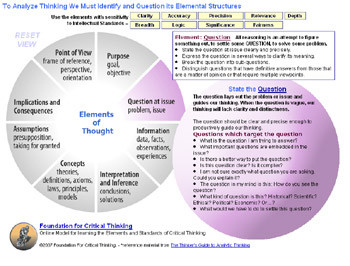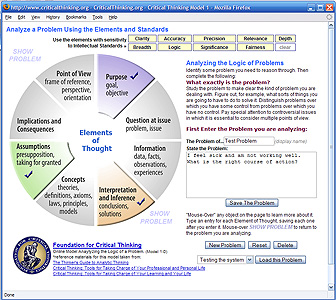Elements and Standards Learning Tool

from http://www.criticalthinking.org/pages/elements-and-standards-learning-tool/783
In this section, we offer an interactive model which details the analysis and assessment of reasoning, and enables you to apply the model to real life problems.
On this page we introduce the analysis and assessment of reasoning. To skip this introduction and go directly to the model, see the links near the bottom of this page.
Why the Analysis of Thinking Is Important
Everyone thinks; it is our nature to do so. But much of our thinking, left to itself, is biased, distorted, partial, uninformed, or downright prejudiced. Yet the quality of our life and of what we produce, make, or build depends precisely on the quality of our thought. Shoddy thinking is costly, both in money and in quality of life. If you want to think well, you must understand at least the rudiments of thought, the most basic structures out of which all thinking is made. You must learn how to take thinking apart.
All Thinking Is Defined by the Eight Elements That Make It Up
Eight basic structures are present in all thinking: Whenever we think, we think for a purpose within a point of view based on assumptions leading to implications and consequences. We use concepts, ideas and theories to interpret data, facts, and experiences in order to answer questions, solve problems, and resolve issues.
Thinking, then:
| Click to Open the "Elements and Standards" Online Model |
Why the Assessment of Thinking is Important
Once you have analyzed thinking, you then need to assess it, using universal intellectual standards. Reasonable persons judge reasoning using these standards. When you internalize them and explicitly use them in your thinking, your thinking becomes more clear, more accurate, more precise, more relevant, deeper, broader and more fair. You should note that we generally focus on a selection of standards. Among others are credibility, sufficiency, reliability, and practicality.
Using the Elements and Standards Online Model
The easy-to-use online model you will find at the following two links were developed to further introduce you to the Elements of Reasoning and Universal Intellectual Standards, and enable you to apply them to real life problems.
These pages are self-guided and self paced, allowing you to move back and forth between the elements and standards. When moving around in the model realize that the cursor will need to be moved carefully around the wheel to keep from activating parts of the model you are not focusing on at the moment. With some practice you will see how the model works and be able to work with it effectively.
Using the Elements and Standards To Analyze a Problem

An interactive extension of the Model Above, this tool will allow you to analyze a problem by identifying each of the Elements of Thought you are using in your reasoning. Pay attention to the intellectual standards as you do so. Your analysis and conclusions can be viewed and printed in a report form when you have completed your analysis. You can save the logics of multiple problems in the database and return to review them or update them at any time.
This tool is available to Members (see complimentary membership) of the Critical Thinking Community. You must be logged in to view and use this resource.
No comments:
Post a Comment